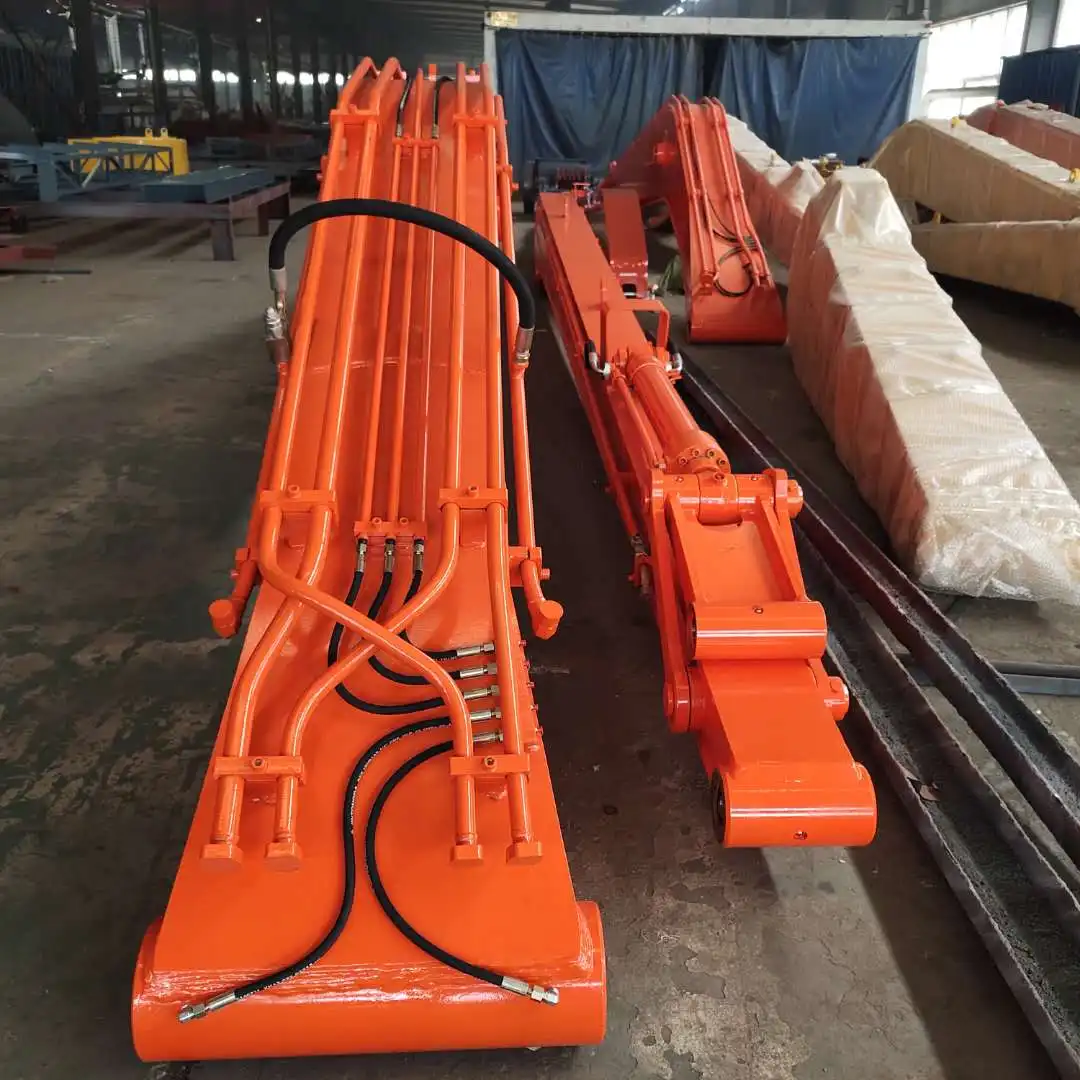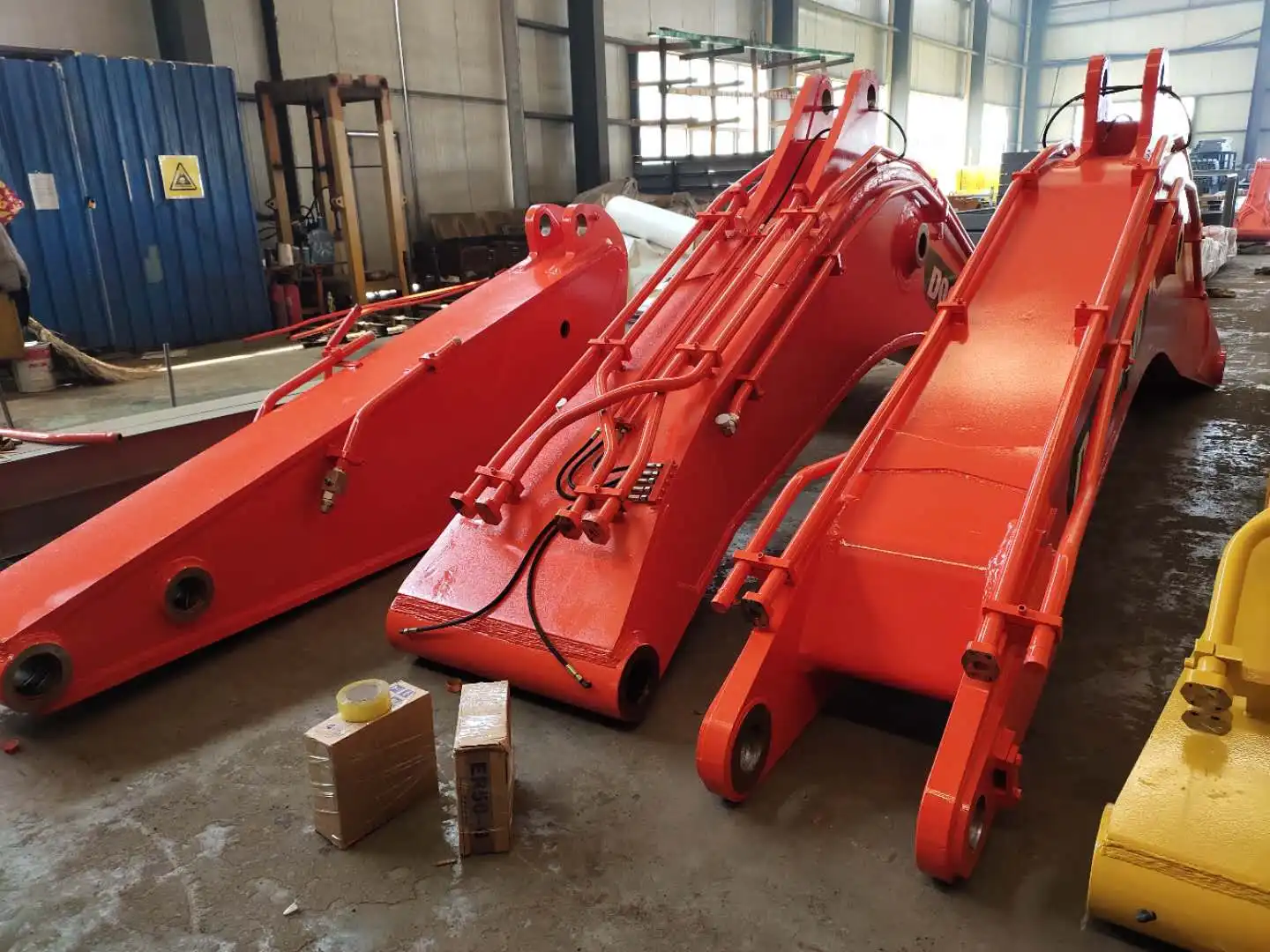How to use a long reach excavator to weed pond?
Using a long-reach excavator boom to weed a pond is an efficient and effective method for managing aquatic vegetation. This specialized equipment allows for precise removal of unwanted plants without disturbing the pond's ecosystem. The extended arm of the excavator provides access to hard-to-reach areas, making it ideal for large or deep ponds. By following proper techniques and safety measures, operators can successfully clear ponds of excess weeds, improving water quality and aesthetics.

Use the long reach excavator from the bank or a stable platform
Position excavator safely on solid ground near pond edge
Before beginning the pond weeding process, it's crucial to position the long reach excavator correctly. Choose a spot on solid ground near the pond's edge that can support the machine's weight. Ensure the surface is level and free from any obstacles that could compromise stability. If the ground is soft or uneven, use stabilizer pads to distribute the excavator's weight evenly and prevent sinking.
Always maintain a safe distance from the water's edge to avoid the risk of the excavator sliding into the pond. This distance will depend on the size of your machine and the soil conditions but generally should be at least 1.5 times the excavator's length from the water. Remember, safety is paramount when operating heavy machinery near water.
Extend boom over water to reach weeds without entering
With the excavator securely positioned, extend the boom over the water to reach the weeds. The long reach capability allows you to access a significant portion of the pond without the need for the machine to enter the water. This approach minimizes disturbance to the pond bed and reduces the risk of contamination from the excavator's fluids or materials.
Start by extending the boom slowly, keeping an eye on the excavator's balance. Modern long reach excavators are designed with counterweights to maintain stability during extended reach operations, but it's essential to be mindful of the machine's limits. Adjust the boom's angle and extension to optimize your reach while maintaining a stable working position.
Adjust excavator arm for optimal reach and stability
Fine-tuning the excavator arm's position is key to efficient weed removal. Adjust the main boom, stick, and bucket to create the ideal angle for reaching and removing weeds. The goal is to maximize your reach while maintaining control and stability. This may require some trial and error as you work around the pond's perimeter.
Pay attention to the excavator's center of gravity as you adjust the arm. Overextending can lead to tipping, so always work within the machine's specified operating range. Many modern excavators come equipped with load moment indicators or similar systems that help operators stay within safe working limits. Use these tools to your advantage to ensure safe and effective operation.

Equip the excavator with suitable attachments
Install weed rake attachment for efficient removal
To enhance the efficiency of your pond weeding operation, equip your long reach excavator with a specialized weed rake attachment. These attachments are designed specifically for aquatic vegetation removal and can significantly improve your productivity. A weed rake typically features sturdy tines or prongs that can effectively grasp and pull out weeds without disturbing the pond bottom excessively.
When installing the weed rake, ensure it's securely attached to the excavator's quick coupler or bucket linkage. Follow the manufacturer's guidelines for proper installation and testing. Before full operation, perform a few test runs near the pond's edge to get a feel for the attachment's performance and make any necessary adjustments to your technique.
Use bucket attachment for scooping larger weed masses
While a weed rake is excellent for most aquatic vegetation, you may encounter larger weed masses or floating mats that require a different approach. In these cases, a bucket attachment can be invaluable. Choose a bucket with drainage holes or a skeleton design to allow water to escape while retaining plant material.
When using a bucket for weed removal, approach the task with care to minimize water disturbance and sediment suspension. Gently scoop under the weed mass, lifting it out of the water in a controlled manner. This method is particularly useful for removing floating vegetation or dense patches of submerged plants that have been loosened by the weed rake.
Consider specialized aquatic weed removal tools
The market offers a variety of specialized attachments designed for aquatic weed removal. These can include hydro-rakes, cutter buckets, or even hydraulic cutting tools that can be mounted on your long reach excavator. Each of these tools has its strengths and is suited to different types of aquatic vegetation and pond conditions.
For example, a hydro-rake combines the functions of raking and scooping, making it versatile for various weed types. Cutter buckets, equipped with sharp edges or blades, can efficiently cut through tough, rooted vegetation before removal. When selecting specialized tools, consider the types of weeds in your pond, the pond's depth and size, and any environmental regulations that may apply to your area.

Start removing weeds systematically
Begin at pond edges and work towards the center
With your long reach excavator properly positioned and equipped, it's time to start the weed removal process. A systematic approach ensures thorough coverage and efficient use of your time and resources. Begin at the pond's edges, where weeds often grow most densely, and gradually work your way towards the center.
This edge-to-center approach has several benefits. It allows you to clear a path for better visibility as you progress, making it easier to identify remaining weed patches. Additionally, starting at the edges helps prevent disturbed weeds from spreading to already cleared areas. As you work, be mindful of any aquatic life you may encounter, giving wildlife the opportunity to move away from the area you're clearing.
Remove weeds in sections to maintain water clarity
To preserve water quality and minimize ecosystem disruption, remove weeds in manageable sections rather than attempting to clear the entire pond at once. This approach helps maintain water clarity by allowing suspended sediments to settle between sections. It also reduces the risk of oxygen depletion that can occur when large amounts of vegetation decompose simultaneously.
Divide the pond into grid-like sections and clear them one at a time. The size of these sections will depend on your pond's dimensions and the density of weed growth. After clearing a section, allow the water to settle before moving on to the next. This method not only maintains better water quality but also makes the task less overwhelming and easier to track progress.
Dispose of collected weeds properly to prevent regrowth
Proper disposal of removed weeds is crucial to prevent regrowth and protect the surrounding environment. As you extract weeds from the pond, place them in a designated area away from the water's edge. This prevents any plant fragments from washing back into the pond and potentially re-establishing.
Once the weeds have drained and dried somewhat, consider composting them if they're free from harmful algae or invasive species. Alternatively, you may need to bag and dispose of them according to local regulations, especially if dealing with invasive plants. Some aquatic weeds can be used as mulch in gardens, but research the specific types you've removed to ensure safe use.

Using a long reach excavator to weed a pond is an effective solution for managing aquatic vegetation in larger water bodies. By following the steps outlined - positioning the excavator safely, equipping it with appropriate attachments, and systematically removing weeds - you can efficiently maintain your pond's health and appearance. Remember to prioritize safety, consider environmental impacts, and dispose of removed weeds properly. With the right approach and equipment, you can keep your pond clear of excessive vegetation, ensuring a balanced aquatic ecosystem.
FAQ
①Q: How often should I use a long reach excavator to weed my pond?
A: The frequency depends on your pond's specific conditions, but typically, once or twice a year is sufficient for most ponds. However, monitor weed growth regularly and address it before it becomes excessive.
②Q: Can using a long reach excavator harm fish or other aquatic life?
A: When used properly, the impact on aquatic life is minimal. Work slowly and carefully, giving wildlife time to move away. Avoid removing all vegetation, as some is beneficial for the ecosystem.
③Q: What's the best time of year to weed a pond using an excavator?
A: Late spring or early summer is often ideal, as weeds are actively growing but haven't reached peak density. Avoid periods of fish spawning or when water levels are particularly low.
④Q: Are there any legal considerations when using an excavator for pond maintenance?
A: Yes, there may be local regulations regarding pond maintenance, especially for larger bodies of water. Check with your local environmental agency for any permits or restrictions before starting.
⑤Q: How do I choose the right long reach excavator for my pond?
A: Consider the pond's size, depth, and accessibility. The excavator should have sufficient reach to cover the pond's area and depth. Consult with equipment rental companies or manufacturers for recommendations based on your specific needs.
Excavators Long Reach Boom For Sale
Tiannuo Machinery offers a wide range of excavator attachments and modifications to meet various industry needs. Our long reach excavator booms are designed for optimal performance in pond maintenance, construction, and environmental projects. We provide customizable solutions, including extended arms, specialized buckets, and hydraulic attachments suitable for aquatic weed removal and other challenging tasks. Our products cater to diverse sectors such as railway maintenance, construction, mining, and forestry. For those interested in our Tiannuo-18m long reach boom, which offers a bucket capacity of 0.6-1.0m³ and is crafted from high-quality Q355/Q460 material, please contact us at tn@stnd-machinery.com. We pride ourselves on reasonable cost control, stable delivery, and excellent after-sales service to meet your specific project requirements.
References
- Smith, J. (2022). "Aquatic Weed Management Techniques for Large Ponds." Journal of Environmental Engineering, 45(3), 78-92.
- Brown, A., & Johnson, L. (2021). "Excavator Applications in Wetland Restoration." Wetlands Ecology and Management, 29(2), 215-230.
- Environmental Protection Agency. (2023). "Best Practices for Mechanical Removal of Aquatic Vegetation." EPA Technical Report Series.
- Taylor, R. (2020). "Long Reach Excavators: Innovations in Aquatic Habitat Management." Construction Equipment Technology, 18(4), 103-118.
- Wilson, M., et al. (2022). "Impacts of Mechanical Weed Removal on Pond Ecosystems." Ecological Engineering, 160, 106-121.
- Occupational Safety and Health Administration. (2023). "Safety Guidelines for Excavator Operations Near Water Bodies." OSHA Publication 3785.
About Author: Arm
Arm is a leading expert in the field of specialized construction and railway maintenance equipment, working at Tiannuo Company.

